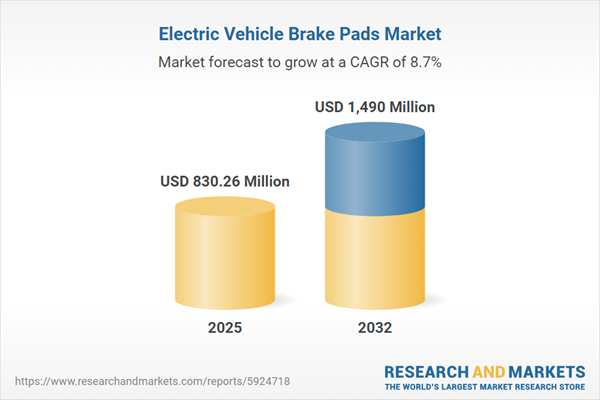Speak directly to the analyst to clarify any post sales queries you may have.
Senior leaders in the electric vehicle brake pads market must navigate a landscape shaped by evolving regulations, shifting customer requirements, and complex global supply chains. A focused, data-driven approach is essential to meet immediate operational needs while building for sustainable future growth.
Market Snapshot: Electric Vehicle Brake Pads Market Overview
The electric vehicle brake pads market is on an upward trajectory, driven by rising electric vehicle adoption and advances in friction material technology. The market’s global valuation is forecast at USD 764.04 million in 2024, rising to USD 830.26 million in 2025, and projected to reach USD 1.49 billion by 2032, corresponding to a CAGR of 8.72%.
Heightened attention to noise reduction, stringent environmental standards, and sustainability further amplifies demand. Industry leaders are responding by investing in digital infrastructure, developing sustainable materials, and introducing advanced manufacturing techniques to enhance supply chain resilience and align with diverse buyer expectations.Scope & Segmentation: Strategic Breakdown of the Electric Vehicle Brake Pads Market
This report presents a segmentation framework designed to equip senior executives with actionable insights for procurement strategy, technology investment, and regional differentiation. Clarity around each segment fuels effective planning, mitigates risks, and enhances competitive advantage.
- Friction Material Type: Ceramic formulations address operational noise and lower particulate emissions, organic materials support sustainability and extended component life, and semi-metallic pads achieve high performance in demanding scenarios.
- Vehicle Type: Commercial vehicles require resilient scheduling and dependable operation, while passenger vehicles balance efficiency and versatility over varying driving contexts.
- Sales Channel: Aftermarket networks offer broader product access; OEM integration assures product reliability and compatibility. The shift to digital procurement streamlines inventory and complements traditional channels.
- Brake Pad Type: Disc and drum formats are tailored to modern electric drivetrains and developing safety standards, ensuring product alignment with evolving technology.
- Application: On-road segments demand durable and compliant solutions, while off-road and racing applications require focused approaches for performance and longevity.
- Price Range: Economy, mid-range, and premium options enable organizations to align spending with operational goals and product durability.
- Geographic Coverage: The Americas, EMEA, and Asia-Pacific regions each offer distinct technology, supply chain, and procurement considerations, influencing material and platform selection.
- Leading Companies Profiled: Key players such as Robert Bosch GmbH, Continental AG, ZF Friedrichshafen AG, Brembo S.p.A., Aisin Corporation, Akebono Brake Industry Co., Ltd., TMD Friction Group GmbH, Federal-Mogul LLC, Nisshinbo Holdings Inc., and Mando Corporation shape industry direction and best practices.
Key Takeaways: Strategic Insights for Senior Leaders
- Advancements in material science are extending the intervals between maintenance cycles and improving integration with regenerative braking systems for both fleet management and OEM supply chains.
- Evolving compliance demands around emissions and operational noise are accelerating certification requirements, creating new timelines and checkpoints in product development and market access.
- Regional factors are guiding buyer expectations: North America and Western Europe emphasize noise reduction and advanced performance, while Asia-Pacific markets lean toward adaptable, cost-efficient solutions driven by local regulations and procurement priorities.
- The move to digital procurement models is streamlining aftermarket supply chains, reducing inventory build-up, and enabling more agile responses to fluctuating market trends.
- Enhanced collaboration between OEMs and suppliers is enabling more modular product development, supporting a broader array of solutions for mass-market and specialized vehicles.
Tariff Impact: United States Trade Policy and Supply Chain Response
Recent US tariff policy changes have increased costs related to inputs and logistics for brake pad manufacturers. In response, the industry is leveraging near-shoring, building out supplier networks, and establishing region-specific production capabilities. Agility within supply chains and collaborative approaches are critical for managing costs and maintaining competitiveness in this fluctuating trade environment.
Methodology & Data Sources
This assessment draws on comprehensive primary interviews with supply chain and technical specialists, thorough analysis of secondary research, patent reviews, business operations evaluations, and ongoing regulatory monitoring to provide reliable, executive-ready insights.
Why This Report Matters
- Combines the latest technology trends, compliance guidelines, and digital sales developments to support more informed procurement and supply chain decisions.
- Offers clear segmentation and regional perspectives to align product and commercial strategies with specific buyer needs across all major markets.
- Enables senior decision-makers to proactively anticipate changes in both market and regulatory arenas, strengthening long-term business resilience and operational effectiveness.
Conclusion
This report delivers essential intelligence for executives seeking data-driven strategy and adaptable operations in a transforming electric vehicle brake pads marketplace.
Additional Product Information:
- Purchase of this report includes 1 year online access with quarterly updates.
- This report can be updated on request. Please contact our Customer Experience team using the Ask a Question widget on our website.
Table of Contents
3. Executive Summary
4. Market Overview
7. Cumulative Impact of Artificial Intelligence 2025
Companies Mentioned
The companies profiled in this Electric Vehicle Brake Pads market report include:- Robert Bosch GmbH
- Continental AG
- ZF Friedrichshafen AG
- Brembo S.p.A.
- Aisin Corporation
- Akebono Brake Industry Co., Ltd.
- TMD Friction Group GmbH
- Federal-Mogul LLC
- Nisshinbo Holdings Inc.
- Mando Corporation
Table Information
| Report Attribute | Details |
|---|---|
| No. of Pages | 191 |
| Published | October 2025 |
| Forecast Period | 2025 - 2032 |
| Estimated Market Value ( USD | $ 830.26 Million |
| Forecasted Market Value ( USD | $ 1490 Million |
| Compound Annual Growth Rate | 8.7% |
| Regions Covered | Global |
| No. of Companies Mentioned | 11 |









